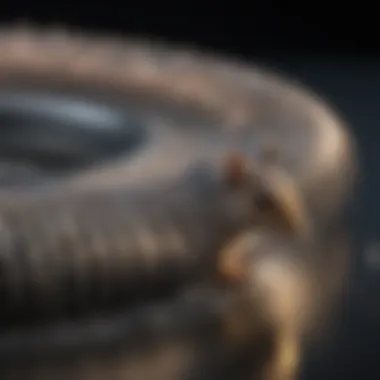Ultrasonic Squirrel Deterrents: Efficacy and Use


Intro
In any home and garden environment, the presence of pests can lead to significant challenges. Among these, squirrels are particularly notorious for raiding bird feeders, digging up gardens, and even causing damage to roofs and attics. This article delves into ultrasonic squirrel deterrents, exploring their effectiveness and implementation in a comprehensive guide aimed at homeowners and gardening enthusiasts.
Understanding the proper techniques for squirrel management is essential for maintaining a harmonious living space. With a focus on the science behind ultrasonic sound waves, the article will also touch upon eco-friendly pest control options that can enhance your current pest management strategy. Readers will gain valuable insights that empower them to choose suitable deterrents and preventive measures, ensuring their gardens and homes remain undisturbed by these agile little creatures.
Preface to Ultrasonic Squirrel Deterrents
Understanding how to manage pest issues, particularly concerning squirrels, is crucial for homeowners and gardening enthusiasts. Ultrasonic squirrel deterrents have gained popularity as eco-friendly solutions that can potentially reduce squirrel activity in residential areas. This introduction will explore their role in pest control, emphasizing the principle of using sound waves to create an environment less appealing to these animals.
Many homeowners face challenges with squirrels, which can cause significant damage to gardens, bird feeders, and property. Conventional methods of pest control, often involving traps or poisons, may pose risks to both non-target animals and the environment. Ultrasonic deterrents offer a different approach, utilizing high-frequency sound waves that many pest species, including squirrels, find uncomfortable. Consequently, these devices may encourage squirrels to relocate without harming them or other wildlife.
The article will provide insights into how these devices operate, their effectiveness based on research findings, and factors that influence their performance. Also, it will examine consumer experiences to give a well-rounded view of ultrasonic deterrents.
Moreover, the benefits of using ultrasonic technology go beyond simple deterrence. Homeowners have the opportunity to integrate these devices with other pest management strategies for comprehensive garden protection. Understanding this integration is essential for maximizing the benefits of these ultrasonic repellents while minimizing any unintended consequences they might have on non-target wildlife.
In sum, the topic of ultrasonic squirrel deterrents represents a significant paradigm shift in pest control strategies. It positions homeowners to address squirrel problems in a less invasive, more sustainable manner.
Understanding Squirrel Behavior
To effectively deter squirrels, it is essential to understand their behavior. Squirrels are curious creatures that often seek food sources in residential areas. They are agile and persistent, able to navigate various obstacles to find seeds, nuts, and bird food. This behavior makes them particularly challenging to manage. Squirrels typically engage in foraging during the early morning and late afternoon, which are ideal times to implement prevention measures.
Their cognitive abilities also come into play; squirrels can learn from their experiences. If they encounter a deterrent without adverse effects, they may become less sensitive to it over time. This adaptability highlights the importance of using multiple strategies in tandem to keep these animals at bay, ensuring that ultrasonic devices do not become ineffective.
The Rise of Ultrasonic Deterrents in Pest Control
Over recent years, ultrasonic technology has emerged as a popular choice for pest control in residential settings. These devices promise a humane method to repel squirrels without resorting to traps or poisons. The effectiveness of ultrasonic deterrents stems from their ability to emit sounds that are beyond the human hearing range. Research indicates that many pests, including squirrels, find these frequencies disturbing, which can lead to changes in their behavior.
The growing awareness of environmental conservation has also propelled the popularity of ultrasonic devices. Many consumers gravitate towards solutions that do not harm wildlife or disrupt ecosystems. Thus, ultrasonic deterrents appeal to a wide audience looking for sustainable and non-lethal options.
Overall, the rise of these technology-based solutions indicates a shift in how society approaches pest management, favoring methods that align with ethical treatment of animals and ecological sensitivity.
Mechanics of Ultrasonic Technology
Understanding the mechanics of ultrasonic technology is crucial for evaluating the overall effectiveness of squirrel deterrents. This technology employs sound waves at frequencies beyond human hearing, which are intended to discourage squirrels from invading spaces such as gardens or attics.
How Ultrasonic Repellents Work


Ultrasonic repellents produce high-frequency sound waves that are typically above 20 kHz. These sound waves can create discomfort for rodents like squirrels without affecting humans or larger pets. The rationale is that squirrels, along with other pests, hear these frequencies well. When exposed to these ultrasonic waves, it can disrupt their echolocation abilities and cause stress. The intent is that the discomfort leads them to vacate the area being protected.
The effectiveness of these devices largely depends on their placement and the surrounding environment. An ultrasonic repellent needs to be strategically installed to ensure optimal coverage. Factors like nearby objects, walls, and even trees can absorb or block these sound waves, reducing their reach. Homeowners should consider these elements when integrating ultrasonic deterrents into their pest management practices.
Frequency Ranges and Animal Hearing
The frequency range of ultrasonic devices generally falls between 20 kHz and 65 kHz. Notably, different animals have varying frequencies at which they can hear. For instance, while many pests including rodents hear frequencies well above 20 kHz, most humans generally cannot hear above this limit.
The understanding of animal hearing is essential to assess how effective these deterrents may be. Squirrels are particularly sensitive to sounds in the upper frequency range, making ultrasonic technology a potential solution. However, not all frequencies will hold the same deterrent effect. Research shows that frequencies between 25 kHz and 55 kHz are often more effective at repelling squirrels.
When utilizing these devices, it is also important to consider how the environmental factors can influence the performance. For instance, background noise from wildlife or urban areas can interfere with the deterrent's effectiveness. Optimizing the conditions can significantly enhance the outcomes achieved through ultrasonic repellents.
High-frequency ranges hold the potential to disrupt typical squirrel activities, yet their effectiveness can be uneven due to multiple external factors.
Evaluating Effectiveness
In the discussion surrounding ultrasonic squirrel deterrents, evaluating effectiveness stands as a pivotal aspect. It is essential not only to understand how these devices operate but also to discern how well they serve their intended purpose. Effectiveness evaluation removes the veil of uncertainty, allowing homeowners to make informed choices based on substantial evidence rather than mere advertising claims. In essence, effectiveness encompasses various attributes including efficiency, usability, and the overall impact these devices have on squirrel behavior.
To accurately assess the effectiveness of ultrasonic squirrel deterrents, a review of scientific research, anecdotal evidence from users, and a consideration of external factors are vital. Homeowners often seek reassurance that their investment will yield significant returns, both in terms of protecting their property and maintaining peace of mind. Therefore, a comprehensive evaluation must take into account direct correlatives like frequency response and distance of sound propagation, as well as indirect influences such as environmental conditions and the behavioral traits of squirrels. The following sections delve into the specifics of research findings, various factors affecting performance, and real-world consumer experiences.
Research Findings on Ultrasonic Deterrent Efficiency
The current body of research indicates a mixed bag of results when it comes to the effectiveness of ultrasonic deterrents. A study published in pest control journals outlines that while some devices can significantly reduce squirrel presence, others show negligible effects. Key findings highlight that ultrasonic sounds can disrupt animal communication and navigation.
- Sound Types: Not all ultrasonic sounds are effective across the board. Studies suggest that certain frequencies resonate better with squirrels and lead to higher levels of deterrence.
- Duration of Use: Continuous exposure to the sound may result in habituation amongst squirrels. Thus, long-term effectiveness may diminish.
- Environmental Conditions: Factors such as wind and humidity can greatly influence how well the ultrasonic waves travel.
To build a reliable framework of deterrent efficiency, more comprehensive studies are warranted. Verification by independent laboratories could enhance consumer trust.
Factors Influencing Deterrent Performance
Several factors influence the performance of ultrasonic squirrel deterrents. The nuances can determine whether these products are a worthy addition to a homeowner's arsenal against squirrel invasions.
- Placement: Proper placement of the device is crucial. Devices should be positioned to maximize coverage area without barriers that could absorb or block the sound waves.
- Type of Surrounding: Open spaces typically yield better results compared to enclosed areas, where sound can bounce off walls and lose effectiveness.
- Device Specifications: The output power and frequency range of a deterrent are significant aspects that dictate its reach and effectiveness. Higher quality devices often yield better results.
- Squirrel Behavior: Understanding local squirrel populations and their adapted behaviors can impact how effective deterrents are. Some populations may be more resilient to ultrasonic sounds.
Consumer Experiences and Testimonials
Consumer experiences provide a rich tapestry of insights into the practical effectiveness of ultrasonic deterrents. Reviews suggest varied results, often directly related to the factors outlined previously. Some users report noticeable declines in squirrel activity soon after implementation, while others express disappointment at the lack of results.
"After installing my ultrasonic deterrent, I saw a significant drop in squirrels coming to my garden. However, it seems that occasional ones still appear, likely conditioned to the sound."


To better absorb these varied experiences, potential users should consider:
- Check Reviews: Look for reviews on specific models to gauge user satisfaction and any recurring themes in experiences.
- Seek Confirmed Results: Consult forums, such as those on reddit.com, where individuals share detailed accounts regarding their use of ultrasonic devices.
- Consider Time Frames: Understand that results may take time and can depend on various external factors.
Comparative Analysis of Ultrasonic Deterrents
The examination of ultrasonic squirrel deterrents is a crucial aspect of understanding their overall performance in pest management. A comparative analysis allows homeowners to make informed decisions regarding which devices may be most effective for their specific needs. By scrutinizing different brands and models, one can discern the similarities and differences that impact efficiency, usability, and cost.
The significance of this analysis lies in its ability to provide clarity. With numerous options available on the market, individuals must navigate through various claims and specifications. This makes it vital to identify which products deliver on their promises and warrant investment. Furthermore, understanding the nuances between offerings can guide users in making selections that align with their environmental values and effectiveness requirements.
Top Brands and Models Reviewed
Several brands dominate the ultrasonic deterrent market. Victor and Pest Repeller are among the most recognized names. These brands offer multiple models, each with unique features. For instance, Victor offers products that can cover large areas, making them ideal for outdoor use. In contrast, Pest Repeller tends to focus on compact devices suitable for indoor settings.
Some common features in these products include adjustable frequency settings, varying power levels, and portability. An important consideration when selecting a model is the range of the ultrasonic sound. Higher-frequency options may be more effective at deterring squirrels but may not suit larger outdoor areas. In contrast, lower-frequency devices may be more suitable for confined spaces.
Furthermore, reviews from consumers highlight additional factors, such as durability and ease of use. Buying decisions can often hinge on these practical considerations as much as the product specifications.
Cost-Effectiveness and Return on Investment
When considering ultrasonic deterrents, evaluating cost-effectiveness is paramount. The initial investment in a deterrent must be balanced against its long-term benefits. In general, ultrasonic devices range in price from modest to premium, depending on features and brand reputation.
One critical aspect to assess is the potential return on investment. For instance, a higher-priced model may save more money in the long term by effectively reducing the costs associated with damage caused by squirrels. Homeowners must consider the cost of repairs and maintenance against the price of the deterrent itself.
In addition, it is essential to factor in energy consumption. Most ultrasonic devices operate on low power, which contributes to overall savings. This not only helps in reducing electricity bills but also limits the environmental impact.
Integrating Ultrasonic Deterrents into Pest Control Strategies
Integrating ultrasonic deterrents into pest control strategies is a key discussion point for effective squirrel management. Given the increasing challenges posed by squirrel populations, understanding how to use these devices is essential for homeowners and property managers. Ultrasonic deterrents operate by emitting sound waves that are beyond human hearing but can affect pest animals like squirrels. This characteristic makes them an appealing option for those who wish to deter pests without using harmful chemicals or traps.
Using ultrasonic devices can create a more sustainable and eco-friendly pest control approach. However, the successful integration of these deterrents requires informed planning and execution. Homeowners need to consider several factors, including the layout of their property, the specific types of squirrels present, and the devices' operating range. Proper positioning of ultrasonic devices can significantly influence their effectiveness.
Best Practices for Use
To maximize the effectiveness of ultrasonic squirrel deterrents, following best practices is important. Here are some recommendations:
- Placement: Position the ultrasonic devices in areas with high squirrel activity. Focus on entry points, feeding grounds, or nests. This increases the likelihood of the devices being effective.
- Coverage: Ensure that the devices are spaced correctly to cover the entire area potential for intrusion. Avoid placing them where obstacles could hinder the sound waves, like thick foliage or walls.
- Frequency Settings: Some devices allow for frequency adjustments. Experimenting with different settings may provide enhanced effectiveness based on the specific conditions of the environment.
- Regular Maintenance: Regularly check the devices to ensure they are operating correctly. Dust, debris, or damage can impair performance.
By adhering to these best practices, homeowners can enhance their chances of achieving a pest-free environment.


Complementing with Other Pest Management Techniques
Ultrasonic deterrents do not need to operate in isolation. Instead, they can be very effective when complemented with other pest management strategies. To boost effectiveness, consider the following strategies:
- Physical Barriers: Install fencing or netting around gardens and key areas of the property. These barriers can prevent squirrels from entering specific zones, working in tandem with ultrasonic devices.
- Habitat Modification: Trim trees and bushes to eliminate easy access to homes or gardens. Reducing available food sources can also deter squirrels from frequenting an area.
- Repellents: Combine ultrasonic devices with natural repellents such as cayenne pepper or vinegar. These substances can create an unpleasant environment for squirrels, increasing the chances of deterrence.
Important Note: The integration of ultrasonic deterrents with these strategies can lead to better results. Adapting multiple approaches leads to a more comprehensive management plan.
Overall, understanding the nuances of integrating ultrasonic deterrents into existing pest control strategies is crucial. This understanding allows for thoughtful implementation, which can lead to effective squirrel management while promoting an environmentally friendly home and garden.
Environmental Considerations
The integration of ultrasonic squirrel deterrents into current pest management strategies brings forth essential environmental considerations. As concern for ecological balance grows, understanding the impact of these deterrents on wildlife and local ecosystems becomes crucial. This section digs into why these factors matter, emphasizing the relevance for homeowners seeking effective yet sustainable solutions.
Impact on Non-Target Species
When deploying ultrasonic deterrents, it is important to analyze how these devices affect non-target animal species. Although designed to repel squirrels, these devices operate on sound frequencies that may influence other wildlife. For instance, rodents, birds, and even pets can all have varying reactions to ultrasonic waves. Emerging research indicates that some frequencies may cause discomfort in non-target animals, while others could be less disruptive.
- Concerns About Hearing: Many animals have a wider auditory range than humans. The frequencies emitted can be irritating or harmful, particularly to animals like dogs and cats. Additionally, wildlife such as rabbits and deer may be repelled by these sounds, potentially altering their natural behaviors.
Homeowners should consider the biodiversity in their environments before implementation. If ultrasonic devices disrupt the balance of species in an area, this could lead to unforeseen ecological consequences.
Ecosystem Responses to Ultrasonic Frequencies
The ecological response to ultrasonic frequencies remains an underexplored area in pest control. Realizing that ecosystems are interconnected is critical. Changes in sound frequency within an area may impact not only the intended pest species but also other facets of the ecosystem.
"Ultrasonic frequencies can influence both predator and prey dynamics within local ecosystems."
One key element in understanding these dynamics is predator avoidance behavior. Some animals may relocate or change their patterns due to the perceived threats from ultrasonic deterrents. This shift could alter feeding and mating habits, impacting food chains and biodiversity.
- Behavioral Changes: Species may begin to avoid areas with ultrasonic devices, causing imbalances in populations. This is particularly relevant for small mammals that serve as prey for predators in the area.
- Long-term Effects: Studies on chronic exposure to these frequencies are limited. Homeowners should recognize that the long-term impact of using ultrasonic deterrents may lead to shifts in species composition over time.
Culmination
The exploration of ultrasonic squirrel deterrents provides essential insights into their role in modern pest control. The effectiveness of these devices stands at the forefront of discussions surrounding humane and environmentally friendly pest management. By understanding how ultrasonic technology operates and its impact on squirrels, homeowners can make more informed decisions.
Final Thoughts on Ultrasonic Deterrents
Ultrasonic squirrel deterrents present a unique option in pest management strategies. They utilize sound frequencies that are beyond the human hearing range, targeting squirrels specifically. This feature minimizes disruption to non-target species, allowing homeowners to maintain their gardens and outdoor spaces without fatal consequences. Importantly, success depends not only on the choice of device but also on proper installation and surrounding conditions. Users must ensure that the deterrents are placed in adequate locations and not obstructed by dense foliage or structures, which can hinder their efficacy. Regular monitoring of the area is essential to observe any changes in squirrel activity, ensuring the chosen solution remains effective over time.
Future Directions in Squirrel Management Technology
Looking ahead, it is clear that advancements in technology will continue to shape the effectiveness of ultrasonic deterrents. Future innovations may include more sophisticated frequency modulation which can adapt to the behaviors of local squirrel populations. Additionally, integrating smart technology within deterrectors, such as mobile app connectivity, will facilitate real-time monitoring and adjustments based on environmental conditions.
Research into bioacoustics might offer new insights that enhance the ability of these devices to** disrupt specific animal behaviors** effectively. Furthermore, there is a call for greater awareness of ecological implications related to pest control methods. As society shifts towards sustainable practices, ultrasonic technology stands as a promising avenue for maintaining ecological balance while protecting property.



